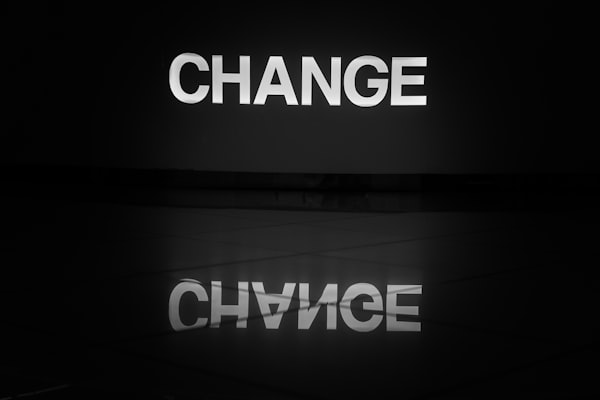
It's been a big year in links … let's start by focusing on change.
This isn't really about change but it is of Radiohead and digital-exhibition-design interest, as the group has a virtual exhibit of sorts on a variety of platforms.
In more typical Museum Human news, Harvard Business Review asked if leaders know why employees really leave; it reminded me of my exit interview post from April.
Org guru John Kotter, along with Vanessa Akhtar and Gaurav Gupta, wrote in HBR on how to survive and thrive, though the advice continues to be very leader-focused. Museums, in particular, are far too concerned with surviving and not with thriving. I also thought of the book I co-wrote with Seema Rao, titled Change at Work: Not Just Surviving But Thriving.
Org consultancy NOBL wrote about change models, blending high-level strategy and adaptation; also check out their guide on getting change started.
This Medium piece from Claire Lew of the Know Your Team blog is fairly standard motivational stuff, but I’ll note one point:
#6: Go big on a “picture of a better place.”
We’ve discussed how to create conditions for your team to feel motivated… But what is it that we want our team to feel motivated about? There must be some ultimate outcome, some culminating end state that is compelling and animating your team to feel excited in the first place, and motivating employees to go above and beyond.
That would be vision: A picture of a better place. A picture of what the future world looks like because of the work you do. The clearer the vision is, the clearer that your team understands what their work adds up to and what they’re building towards.
The question is: How clear have you been illustrating this vision? I recently spoke with a CEO who admitted that though their mission and values were very clear, their vision was blurry. “ I’ve been talking a lot about the work we do,” shared this CEO, “ but not illustrating the end state, the better world we create, because of it.”
I think of this especially with DEIA work, how museums aren't painting a picture of what the changed institution will look like, perhaps because they don't want to worry the established white power structure that may not be a part of that new future. Note that here, I don't just mean leaders, but everyone in the org who benefits from that PWI leadership structure, even if people may feel victimized by long hours and low pay, etc.)
Back to HBR, here's an article on improving employee engagement. I was hopeful when I read "offer employees the flexibility to try new work tasks so they can discover their intrinsic interests," "grant employees more autonomy," and, especially, "create time affluence." (Here's a whole post of mine about providing museum workers with time.) But the advice boiled down to:
Encourage employees to invest in time-saving purchases. Time-saving purchases (e.g., housecleaning, meal delivery services) enable employees to spend money on products in return for more leisure time, increasing their feelings of time affluence.
Uh, no, on so many levels.
HBR also wrote about using agile as a method for generating change. The story of how General Electric supposedly lost its way by, among other things, getting too involved in org culture experimentation, is held up as an argument not to change. Supposedly, activist investors demanded that GE stop experimenting and start generating more returns for investors. It's sobering thoughts for museum workers who want to put change—favoring workers, neighbors, and visitors—above board, donor, and bottom-line demands.
Here's an interesting piece on how Zappos evolved beyond pure Holacracy, the ultimate in experimental org culture methods.
Finally, HBR had a good piece on meeting overload—if we're going to get anything out of our remote/hybrid work experiment, please let it be that we had too many meetings in person and now have too many remote meetings. I quote at length three reasons the article supplied for the false sense of a need to meet:
2. Selfish Urgency
We all fall prey to the Egocentric Bias from time to time — that is, the tendency to focus more on our own needs, desires, and perspectives. When it comes to meetings, this bias yields a phenomenon that we call “selfish urgency.” That is, leaders will schedule meetings whenever convenient for them, without necessarily considering their teams’ needs or schedules. Sometimes leaders even knowingly schedule meetings when their team has conflicts, forcing everyone to shift their calendars around to accommodate.
To be clear, while this can be extremely frustrating, selfish urgency often isn’t malicious. People are notoriously bad at recognizing opportunity costs, meaning it may not even occur to many leaders that scheduling a meeting means their team will be unable to spend the time doing something more valuable. It’s also easy for good intentions to get lost in the daily grind. In a past job, one of us had a long commute, so our manager very kindly blocked off 4 to 5pm in our calendar so we could beat the rush hour traffic. This compassion lasted a full 24 hours: By day two, that block was full of meetings.
To address these challenges, leaders should proactively remind themselves to think about the opportunity costs associated with asking their teams to attend a meeting. These could be financial costs — for example, one company found that a single weekly meeting of middle managers was costing the organization more than $15 million dollars a year — or more personal costs, such as employees’ lost commute time or mental energy.
If you’re having trouble, try using a tool like this one that calculates a monetary cost per meeting, or talk to your team to find out how meetings are impacting their personal and professional lives. And of course, once you’ve become more aware of the costs, see if there are ways you can address them. Instead of interrupting people’s workflows with a last-minute invite, try to schedule meetings in advance. Do your best to find mutually convenient times, and consider shortening or cancelling a meeting altogether if the benefits don’t seem to outweigh the downsides.
3. Meetings as Commitment Devices
Sometimes we use meetings as commitment devices: that is, mechanisms to help make sure people follow through on their promises. Behavioral science shows that an external deadline (like a meeting with your boss) can be an effective motivator — but the meeting itself is often unnecessary, with people simply reporting on how they did or didn’t achieve the agreed-upon target.
To address this issue without losing the motivating effect of meetings as commitment devices, tell your team in advance that the meeting will be cancelled if the deadline is met — essentially framing cancellation as the reward for reaching the goal. If the work isn’t done in time, the meeting will likely still be helpful, since the unforeseen factors that led to the delay will likely benefit from discussion. If the work is done, send a congratulatory email and save everyone an hour. And if everyone is done except Steve, don’t have the meeting; instead, find another way to hold Steve accountable without wasting everyone else’s time.
4. The Mere Urgency Effect
When we are stressed, completing seemingly urgent (yet actually unimportant) tasks can provide some relief. This is known as the Mere Urgency Effect. Scheduling and attending meetings can make us feel like we’ve accomplished something, and so we’re often loath to decline or cancel them, even if they are objectively not as important as our other work. This is often compounded by a strong sense of inertia: If we’ve always held a certain meeting at a certain time, it’s a lot easier to just keep doing that than to reevaluate whether it’s actually a good idea.
And, yes, I've argued that more workers need to be involved in more discussions across the institution—the challenge, then, is figuring out how to do this without adding to our meeting load.
I'll have a whole lot more links over the next two weeks, so enjoy!
PS: I noticed that the past three newsletters have had lower than usual open rates. It's very possible that this is because of the holiday and gearing up for end-of-year deadlines, but, just in case you didn't have a chance to read the past couple of posts, here they are:
- November 30: So I Missed My Museum's Orientation (subscribers only)
- November 23 (no Links of the Week last Friday): Museum Home Work (with Survey Results) (subscribers only)
- November 19: Links of the Week: November 19, 2021: Post-Conference-Era Follow-up
If you're reading this and not a subscriber to Museum Human, consider signing up for a free subscription below—it's the only way to read the site's longer weekly post on the organizational culture of cultural organizations. Thank you for reading!
cover image by Nick Fewings / Unsplash [description: the word change in white letters against a black background, reflected on a dark surface below]

Links of the Week: December 3, 2021: Everything Must Go by Robert J Weisberg is licensed under a Creative Commons Attribution-NonCommercial-ShareAlike 4.0 International License.






